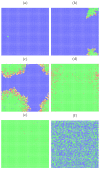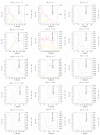Does Social Distancing Matter for Infectious Disease Propagation? An SEIR Model and Gompertz Law Based Cellular Automaton
- PMID: 35741552
- PMCID: PMC9222381
- DOI: 10.3390/e24060832
Does Social Distancing Matter for Infectious Disease Propagation? An SEIR Model and Gompertz Law Based Cellular Automaton
Abstract
In this paper, we present stochastic synchronous cellular automaton defined on a square lattice. The automaton rules are based on the SEIR (susceptible → exposed → infected → recovered) model with probabilistic parameters gathered from real-world data on human mortality and the characteristics of the SARS-CoV-2 disease. With computer simulations, we show the influence of the radius of the neighborhood on the number of infected and deceased agents in the artificial population. The increase in the radius of the neighborhood favors the spread of the pandemic. However, for a large range of interactions of exposed agents (who neither have symptoms of the disease nor have been diagnosed by appropriate tests), even isolation of infected agents cannot prevent successful disease propagation. This supports aggressive testing against disease as one of the useful strategies to prevent large peaks of infection in the spread of SARS-CoV-2-like diseases.
Keywords: SARS-CoV-2-like disease spreading; compartmental models; computer simulation; epidemy.
Conflict of interest statement
The authors declare no conflict of interest.
Figures








Similar articles
-
Extended Kalman filter based on stochastic epidemiological model for COVID-19 modelling.Comput Biol Med. 2021 Oct;137:104810. doi: 10.1016/j.compbiomed.2021.104810. Epub 2021 Aug 28. Comput Biol Med. 2021. PMID: 34478923 Free PMC article.
-
Estimates of the collective immunity to COVID-19 derived from a stochastic cellular automaton based framework.Nat Comput. 2022;21(3):449-461. doi: 10.1007/s11047-022-09893-3. Epub 2022 Jun 18. Nat Comput. 2022. PMID: 35757184 Free PMC article.
-
SEAHIR: A Specialized Compartmental Model for COVID-19.Int J Environ Res Public Health. 2021 Mar 6;18(5):2667. doi: 10.3390/ijerph18052667. Int J Environ Res Public Health. 2021. PMID: 33800896 Free PMC article.
-
Compartmental Models of the COVID-19 Pandemic for Physicians and Physician-Scientists.SN Compr Clin Med. 2020;2(7):852-858. doi: 10.1007/s42399-020-00330-z. Epub 2020 Jun 4. SN Compr Clin Med. 2020. PMID: 32838137 Free PMC article. Review.
-
Disease spreading with social distancing: A prevention strategy in disordered multiplex networks.Phys Rev E. 2020 Aug;102(2-1):022310. doi: 10.1103/PhysRevE.102.022310. Phys Rev E. 2020. PMID: 32942454 Review.
Cited by
-
The Psychosocial Resonance of Food Safety Risk: A Space-Time Perspective.Foods. 2025 Jun 26;14(13):2260. doi: 10.3390/foods14132260. Foods. 2025. PMID: 40647012 Free PMC article.
-
Modeling COVID-19 spread using multi-agent simulation with small-world network approach.BMC Public Health. 2024 Mar 2;24(1):672. doi: 10.1186/s12889-024-18157-x. BMC Public Health. 2024. PMID: 38431581 Free PMC article.
-
Dissipative, Entropy Production Systems across Condensed Matter and Interdisciplinary Classical vs. Quantum Physics.Entropy (Basel). 2022 Aug 9;24(8):1094. doi: 10.3390/e24081094. Entropy (Basel). 2022. PMID: 36010757 Free PMC article.
References
-
- WHO COVID-19 Dashboard. World Health Organization; Geneva, Switzerland: 2020. [(accessed on 1 June 2021)]. Available online: https://covid19.who.int/
-
- Worldometers: COVID-19 Coronavirus Pandemic. 2021. [(accessed on 1 December 2021)]. Available online: https://www.worldometers.info/coronavirus/
LinkOut - more resources
Full Text Sources
Miscellaneous

